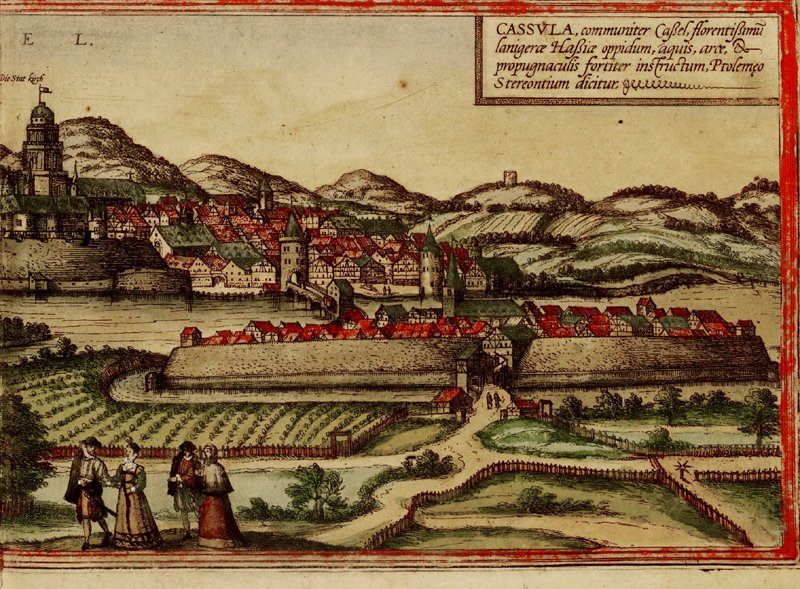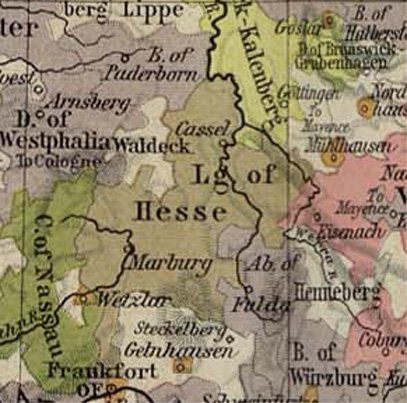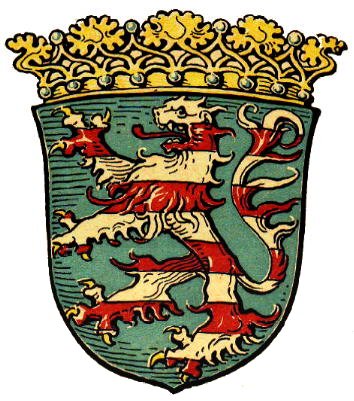UNDER
CONSTRUCTION


The
above illustration from the 1600's is one of the earliest
color examples that clearly defines how the eye would have
perceived Medieval-era Hesse-Kassel. Notice the splendid colors.
If this is not artistic interpretation and is indeed what
the artist truly saw in reality, it is an amazing use of color
on all of the buildings' roofs in red and green.
Kassel:
An outline of the city's development
Authors:
Frank-Roland Klaube and http://www.achwir.net/
The city's name is derived from the ancient Castellum Cattorum,
a castle of the Chatti, a German tribe that has lived in the
area since Roman times.
Kassel
is first mentioned in 913 as the place where two deeds had
been signed by king Conrad I of Germany. The place was called
Chasella and was a fortification at a bridge crossing the
Fulda. A deed from the year 1189 certifies that Kassel had
city rights. The exact date of their grant is not known. These
are the first written proof for Kasselís existence and therefore
the evidence that the city can look back on a more than thousand
year history. Of course in the beginning one cannot speak
of a city. On the site of our government headquarter today,
once stood a fortress, protecting a settlement that grew over
the next couple of centuries. The
place was called Chasella and was a fortification at a bridge
crossing the Fulda river. A testimony of the small size of
the settlement is the street name GRABEN. A deed from 1189
certifies that Kassel had city rights, but the date of their
conveyance is not known.
After Landgraf (landgrave) Heinrich from Hessen chose Kassel
as his government residence in 1277, the size of the city
as well as its economic importance grew.
Brüderkirche, Martinskirche, Druselturm and Zwehrenturm
date back to this time. Particularly in the second half of
the 14th century the cityís council fought, in vain, to obtain
more independence. The result was that the landgraves kept
a strong hold on the cityís development for more than 500
years.
Hesse-Kassel
in the Middle Ages
from
http://de.wikipedia.org/wiki/Geschichte_Kassels
The
Emperor proclaimed in 1292, that the capital of the Land of
Hessen shall be Kassel, as realm principality.
The
first mention in the kings court of Kassel (at that time under
the name Chassalla and/or Chassella) is on 2 documents of
the German king Konrad I from the year 913. At that time the
king's court resided in the Stadtschlosses, which was moved
around 1143 to the residence of the ludowingischen count Heinrich
Raspe von Hessen (or Gudensberg as the case may be). Sometime
before1189 Kassel attained the municipal law. Between 1140
and 1148 the Prämonstratenserinnenstifts is created on
the Ahnaberg at the north end of the city at that time, the
Ahnaberger monastery.
After
the final overthrowing Hessen von Thuringia, the new Landgrave
Heinrich I von Hessen made Hessen Kassel his residence and
capital of the Land Hessen in the year 1277. He created (Unter-)Neustadt
and appointed the Carmelites to Kassel in 1292. This mendicant
order builds the Brüderkirche (brother church), the oldest
surviving building of the city today. In the year 1297 Mechthild
of Kleve, the wife of Landgraf Heinrich I. von Hessen, created
the Elizabeth hospital, one the first Siechenhäuser (hospital/ailing
house)of Kassel.
With
the increasing importance of Kassel, the number of inhabitants
raised, and around 1330 land count Heinrich II. extends the
city with a district named Freiheit (Freedom). Soon after
it in their center the foundation-stone for the Martinskirche
(St. Martin's Church)is put (around 1366/67 with a Chorherrenstift:
choir gentleman pin). It is an indication of the emancipation
of the diocese of Mainz and developed the mental center of
Hessen.
In
1378 the three independent cities (Altstadt, Neustadt, Freiheit)
are combined.
Oberneustadt,
the Oktogon and of the Orangerie wasn't added until almost
1700; the Löwenburg wasn't added until 1800..
GUILDS
| MEN |
WOMEN |
as
of 1421, there are 10 guilds in Kassel:
Garb
(clothes) cutter,
Wool Weaver,
Line weaver,
Tailor,
Shoemaker and Tanner,
Weißgerber (tawer: to make white leather),
Kürschner (Furrier or pelt monger),
Smithy,
Baker,
Butcher
|
Women
who lived in towns were free of feudal obligations,
though control by male relatives was a given. Town women
were protected from rape and seduction because they
were valuable commercial assets. |
| |
|
DISTRICTS
POINTS
OF INTEREST
Altmarkt
and Rathaus
 |
| Left:
This pre-1900's illustration would also reflect the Altmarkt
of Kassel in the 1470's. The center building is the Rathaus,
or city Hall, built in 1408. |
 |
|
|
Scene of a Market during 15th century |
|
CITY
MAP
| Newly
translated corrections for the key have been made. an
updated Key will be uploaded soon. |
|
 |
| |
|
| LAND
MAP |
|
 |
|


Coat
of arms for Hesse. left: recreation. right: original. |

scene
of death, from a Kassel artist in the 1470's |
|